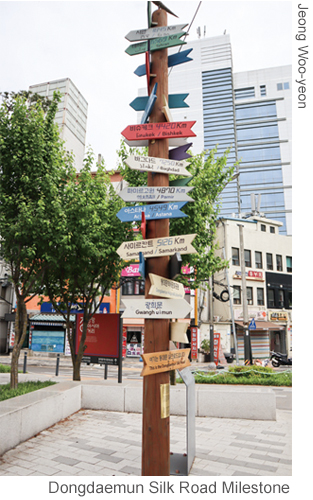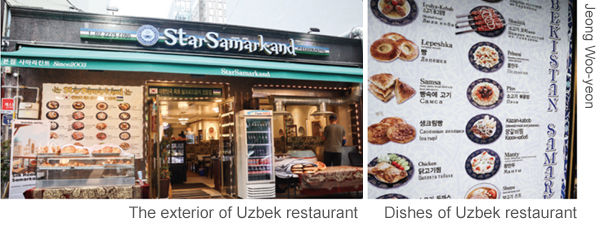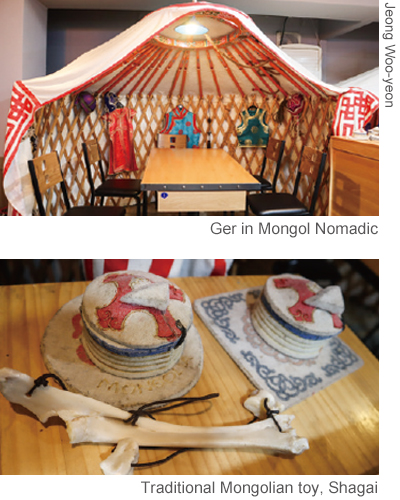Have you ever heard of or visited Korea Town? Korea Town is the area where Koreans live in clusters in other countries and there are various Korean elements. Contrarily, Central Asian Street is a place in Korea where a street from a foreign country seems to have been relocated.

In Gwanghui-dong, there is a Central Asian Village where several Central Asians from Russia, Kazakhstan, and Mongolia live. Once you enter this place, you can feel a unique scent that clearly differs from Korea. Signboards all over the street are filled with Cyrillic alphabets that are unfamiliar to most Koreans but are often used in Russia and Central Asia.
Central Asian Street is also called the “Dongdaemun Silk Road” due to its unique appearance. Silk Road used to be the trade route between the East and the West and included regions such as the Pamir Plateau, Moscow, and Ulaanbaatar among others. In fact, there are milestones at the Gwanghui-dong intersection for Central Asia and the Silk Road, which is also of interest to visitors. You can find the amazing Central Asian Village behind the Gwanghui building at exit 5 of the Dongdaemun History and Culture Park Station on subway lines 2, 4, and 5.
The Central Asian Village was established in the early 1990s. After Korea and Russia established diplomatic relations in 1990, Russian merchants and dealers started to gather in Dongdaemun clothing stores and settle in this area. Subsequently, a Russian street was formed and clothing wholesalers were concentrated in Dongdaemun. People from Central Asia, including Uzbekistan, Kyrgyzstan, Kazakhstan, and Mongolia, also visited this place to exchange and remit money. Since then, Russian merchants have left for China as Russia’s economic situation worsened, and migrants from Central Asia and Mongolia have settled here.
Four Attractions on Central Asian Street
Central Asian Street is a space that gives the impression of the Silk Road as more than 150 stores, including brokerage agencies, restaurants, and grocery stores, are concentrated here. The Gwanghui-dong intersection has milestones for Central Asia and the Silk Road, which is also of interest to visitors. Above all, various foods from Central Asia and Mongolia are the most enjoyable part of Central Asia Street that should not be missed. The UOS Times would like to introduce a few attractions on this street.
1. Uzbek Restaurants

Uzbek restaurants, with names such as Samarkand and Star Samarkand, are located in a narrow alley on Central Asia Street. The place is reminiscent of the back alleys of Samarkand, which served as a crossroads of world culture. In the oven in front of the store, you can see the owner baking the traditional bread named “Samsa.” In Uzbekistan, lamb dishes are popular because 80% of the people are Muslims, who do not eat pork. Thus, everyone, including those who do not eat pork, can enjoy traditional Uzbek lamb dishes. Uzbekistan-style dumplings “Manty” and fried rice “Plov” are popular among visitors, regardless of their nationality. There are twelve Uzbek restaurants throughout Korea, and four of them are on the streets of Central Asia; thus, it would be a good experience to try traditional Uzbek food.
2. Mongol Nomadic Restaurant

Upon entering the Mongol Nomadic Restaurant on the second floor of Mongolia Street in Central Asia Street, the traditional Mongolian structure “ger” can be found. Traditional Mongolian costumes and musical instruments are kept inside the ger, and a traditional Mongolian toy “Shagai” made of sheep’s ankle bones can be found on the table. Shagai is similar to “Yut” used in Korean (Yutnori is a traditional Korean game played using four sticks between two partners or two teams in turns), and Mongolians sometimes tell fortunes with Shagai. The restaurant’s signature menu is “Hurhuk,” a traditional Mongolian dish with lamb chops steamed on hot stones. Mongolian stir-fried noodles “Choi Wan” and traditional dumplings “Hoshor” are also popular dishes.
3. Imperia Foods

“Imperia Foods” is a supermarket and bakery that sells groceries from Russia and Central Asia. Customers of various Russian-speaking nationalities visit this place. The store offers canned goods, frozen foods, sausages, snacks, and drinks from Georgia, Russia, Ukraine, and Armenia. Inside, there is a variety of large, rugged-shaped Russian and Uzbek traditional bread, and many people have been visiting here to taste them. Moreover, tea and simple food items such as omelets, burgers, and Russian sandwiches are also sold. There are seats for customers on one side of the store.
4. Russian Cakes

Without fancy interiors or special names, there is just a big sign with “Russian Cakes” written in several languages. It is a unique cake business that cake enthusiasts frequently visit after becoming viral on social media. You can taste Russian cakes and pies made by a Russian patissier. “Napoleon” or the “Emperor̓s Cake” is one of the most popular items on the menu. “Medovic,” a Russian-style honey cake, is the national dessert of the Russians. The restaurant owner recommends the Ukrainian “Kyiv” cake. Piece cakes can be ordered as a whole, if a reservation is made in advance.
There are about 170 people of various nationalities living in the Central Asian Village and 300 floating population per day. However, on weekends, many foreign workers from the metropolitan industrial complex flock to this area, approximately 1,000 people per day. As the number of people from other countries settling in Gwanghui-dong increases, the Jung-gu Office in Seoul is carrying out various support projects such as launching Korean language classes for the people from various countries and establishing information centers.
These measures are expected to gradually attract more people to Korea. Other than Central Asia Village, there are several other villages showcasing cultures of other countries, including the Muslim Africa Town in Itaewon, Japanese Village in Yongsan-gu, and Seorae Village in Banpo-dong. All of them have become tourist attractions and are helping to strengthen the commercial districts.
These places allow people from various nations to practice their unique culture and offer a great opportunity for tourists to gain novel experiences. How about visiting these villages and experience the diversity of the world?
Jeong Woo-yeon
wyjung0228@naver.com

